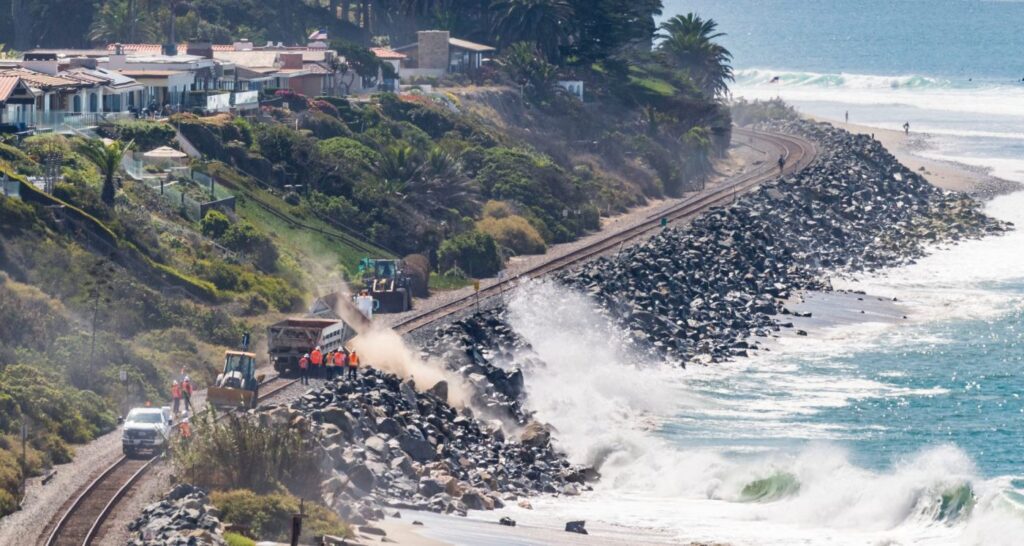
Trains should be back on track running through south San Clemente by February, Orange County Transit Authority officials told the California Coastal Commission during an update on Wednesday, Dec. 14.
Passenger service was halted in September after the ground under the tracks shifted, causing safety concerns.
Jason Lee, project manager with the OCTA’s rail programs, gave a presentation at the commission’s meeting highlighting the work underway to address track and landslide damage in south San Clemente, just below the private community of Cyprus Shores, to secure the area so train service can resume.
The $12 million emergency repair project has added truckloads of boulders on the ocean side of the beachfront tracks to protect them from waves and crews are driving large steel anchors into the bedrock of the slope on the land side to prevent it from pushing the tracks further toward the ocean.
This was the second time in a year passenger service was halted because of track movement. When the initial damage occurred in 2021, the OCTA put in a monitoring system to detect landslide movement. That December, movement indicated an additional need for more boulders, called rip rap, to be placed.
Readings were stable between February and August of this year, until September when a high tide combined with Hurricane Kay, which brought rain and big swells, eroding some of the rip rap and causing the landslide area to shift again, Lee said.
“October data showed not only that the recent landslide is moving, but a larger ancient landslide is moving as well,” he said.
Lee also showed commissioners pictures from 2004 showing a wide, expansive beach along the coastal section of the rail line and then another image from last year that showed a beach that had mostly disappeared.
Read our series looking at coastal erosion issues
Southern California coastal towns are losing valuable sand, putting some beaches at risk
An Orange County coastal town grapples with losing its beach
Can Southern California save its disappearing beaches?
“On the west side of the tracks we’re dealing with ocean intrusion,” he said. “Sand loss (is) leading to issues on the ocean side of the tracks.”
About 8,600 tons of rip rap have been placed to date.
Completion of the ground anchor installation should be done by the end of the month, Lee said, and the entire project finished by February.
Occasional freight trains are able to run through the area and passenger service south to the San Clemente Pier resumed in early November. Northbound trains stop at Oceanside.
The next step will be to work with Coastal Commission staff on the agency’s planned feasibility study to review vulnerable areas along the 7-mile stretch of the rail corridor from Dana Point to San Clemente, Lee said, and come up with short, medium and long-term infrastructure considerations, which will look into strategies for rail alignment and alternative concepts.
Coastal Commission Chair Donne Brownsey wondered if the feasibility study will include relocation of the train tracks further inland.
“We’ll be looking at all the options,” Lee responded.
A map included in the presentation showed areas with existing rip rap, as well as areas without that are considered “vulnerable.”
OCTA officials want the Coastal Commission to allow for rip rap to be added along those areas without the need for future emergency permits.
That request concerned Rick Erkeneff, who addressed the commission during Wednesday’s meeting on behalf of the Surfrider Foundation’s South Orange County chapter. He said the organization through the years has been vocal about sea level rise and erosion problems at the site of the coastal railroad tracks.
“We’ve known for a long time the beach erosion is jeopardizing the tracks,” he said. “The latest emergency closer to the line is no surprise.”
He called the emergency permitting process “frustrating” because it doesn’t allow for comprehensive studies or comments from the public.
